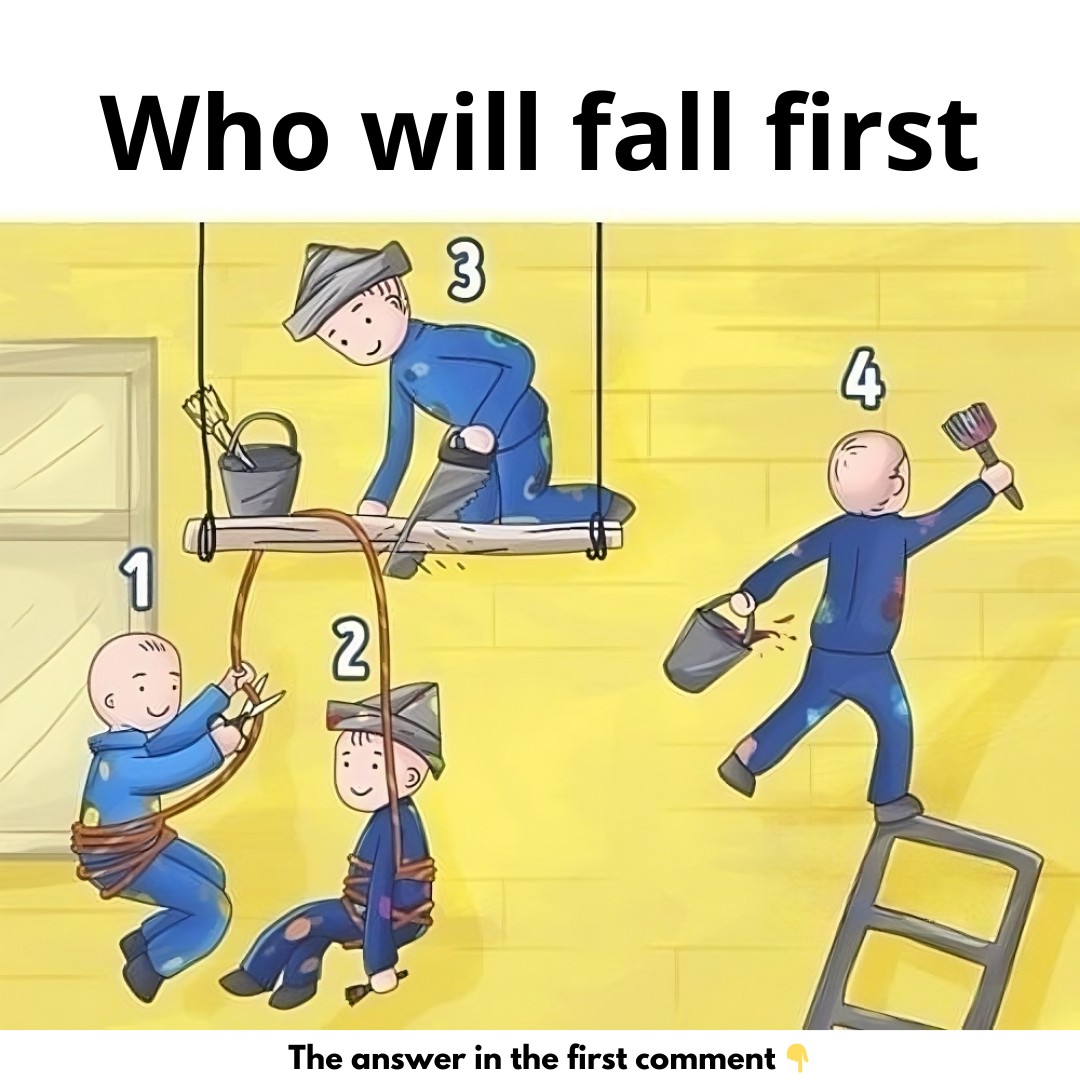Life often presents us with puzzles that go beyond simple curiosity—they test how we observe, think critically, and apply logic to unusual scenarios. One such brain teaser that has intrigued many is the seemingly simple question: “Who will fall first?”

At first glance, it might seem like a straightforward observation test, but this riddle dives deep into our understanding of balance, cause and effect, and human behavior. Picture the scene: four painters are working on a bright yellow wall, each one in a different position, and each facing a different type of risk. Painter #1 is standing firmly on the ground, holding a rope that keeps a wooden plank suspended mid-air. Painter #2 is calmly sitting on that suspended plank, relying completely on the rope held by Painter #1. Painter #3, however, is standing on the same plank and is in the process of sawing it in half. Meanwhile, Painter #4 is up on a ladder, balancing a bucket of paint while reaching up to finish the top section of the wall.
Your challenge is to determine who among them is the most likely to fall first. While it may be tempting to go with the obvious choice—Painter #3, who is literally cutting through the platform he’s standing on—there’s more complexity to the scene than initially meets the eye. One of the biggest mistakes people make with puzzles like this is rushing to conclusions without taking all the variables into account. For instance, many jump to the idea that cutting the plank will lead to an immediate fall, but that ignores the time it takes to saw through a thick piece of wood. In that same span of time, something else could go wrong with another painter. Additionally, we must not ignore key details such as the rope’s stability or the position of the ladder, which could change everything.
Now let’s take a closer look at the risks associated with each painter. Painter #4 is balancing at the top of a ladder, which is inherently unstable, especially when someone is trying to reach and manage a paint bucket at the same time. If that ladder tilts, slips, or is not well-positioned, a fall is practically guaranteed—and it would happen quickly. This places Painter #4 at high risk. Painter #3, despite sawing the plank he’s standing on, still has time before the plank actually gives out.
While his fall is likely, it’s not necessarily imminent, meaning the danger is moderate rather than immediate. Painter #2 is sitting on the same plank and is completely dependent on both the stability of the plank and the rope being held by Painter #1. If Painter #3 finishes cutting or if Painter #1 lets go, Painter #2 will fall—but again, nothing Painter #2 is doing directly threatens their own safety in the short term. As for Painter #1, their role in the situation is critical, but their own safety is relatively secure. Standing on solid ground, their chance of falling is practically zero unless something truly unexpected occurs. After analyzing all these positions and risk factors, the clear answer is that Painter #4 is the most likely to fall first. Their position on the ladder is the most unstable, and any sudden movement or shift could cause an immediate fall. The added weight of the paint bucket increases this risk even further. Painter #3 follows next in risk, but again, only once the sawing is complete.

This riddle is such an effective mental challenge because it forces us to go beyond our first impressions and look at the full picture. It makes us pay close attention to the physical environment, anticipate the chain of events, and understand how small actions lead to bigger consequences. Puzzles like this not only entertain but also train our minds to notice subtleties, develop sharper analytical thinking, and resist the urge to settle for the obvious. They remind us of the importance of patience, logical reasoning, and looking at situations from multiple angles. In the end, the question of “Who will fall first?” teaches us to value process over impulse and to see puzzles not just as games, but as valuable exercises in thinking. Based on all evidence and risk factors, the answer points to Painter #4 as the one most likely to take the first fall—thanks to the unstable nature of ladders, the unpredictability of balance, and the added complication of a paint bucket. But like many riddles, the fun lies in the interpretation. What do you think? Does the logic hold up, or do you see a different outcome in this clever little mystery?





